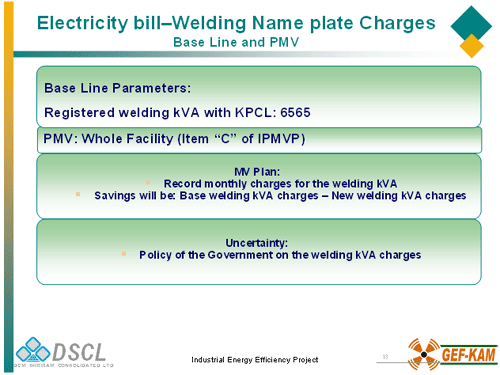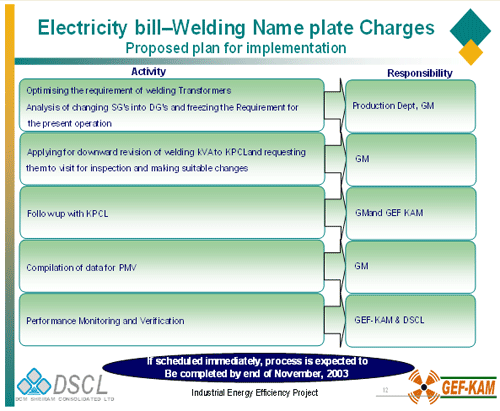Dr G C Datta Roy, CEO, DSCL Energy Services Co Ltd, India
R Rajmohan, Sr Consultant, DSCL Energy Services Company
Background
In the year 2001, an industrial energy efficiency program was launched by Ministry of Industry, Government of Kenya with support from UNDP-GEF. A five year program called ‘GEF-KAM Industrial Energy Efficiency Project’ is being operated by the project management unit (PMU) set up at the Kenyan Association of Manufacturers. The followings are the key objectives of the project.
- To remove technical, information, financial and institutional barriers against implementation of energy efficiency (EE) projects in the industrial and commercial sectors
- Enhance application of EE technology and investment in the SME sector
- Reduce GHG emission
- Produce high quality product at lower cost for making Kenya globally competitive
- To increase institutional capacity to implement EE projects.
The program components comprise of:
- Awareness campaign through development of EE network, Energy Management (EM) Award (EMA), publications and seminars
- Capacity building for industry and consulting with support from international and local experts
- Implementation of demonstration retrofit projects
- Development of financing mechanism and bankable project proposals
- Strengthening industry to undertake EM activities
- Working with Government and other stakeholders to develop national policy, strategy and institutions for EE development
- Assisting emergence of ESCOs.
Large number of EE consultants from many countries including Canada, Germany, UK, South Africa, Zimbabwe and India has been involved in providing services for the different program components.
DSCL Energy Services Co Ltd (DSCL ES), one of the largest energy consulting organisations in India was contracted for providing consulting and engineering services for implementation of the demonstration projects and training for capacity building.
The demonstration project implementation program was designed to catalyze replication of similar projects widely. It has been the experience of DSCL ES that a credible M&V system is the most important pre-requisite for the same. DSCL ES proposal for integrating M&V system as part of project implementation received enthusiastic response from the PMU and project participants. This article briefly describes how M&V system was developed using the IPMVP protocol and the consequent benefit derived by the participating industries.
Brief assignment summary
DSCL ES was engaged in July 2003 and the assignment for was divided into following three missions:
Mission-1
a. Review of the energy audit (EA) reports prepared by the previous EA consultants; develop energy baseline and familiarizing the participating industries on M& V need and IPMVP protocol.
b. Assessment of local capacity for project procurement and implementation
c. Preparing execution plan
Mission-2
a. Review of status of project implementation
b. Putting M&V system in place
c. Developing MIS
d. Assistance in project execution as per request
Mission-3
a. Review of the status of the MV plan proposed for the implemented energy saving measures during mission 1&2 and documents any changes that could affect the results of PMV.
b. Review the implementation status and document any changes that could impact the expected energy savings.
c. Propose suitable baseline parameters, PMV option and MV plan for the measures under implementation.
d. Design suitable PMV option and MV plan for the long term measures so that the industry concerned could carry out the PMV.
e. Review the energy consumption pattern/process of all the participating industries and if found modified, factor the changes in the baseline and the PMV in consultation with the PMU and the concerned industry
f. Oversee and follow up the on going implementation of the additional measures identified during mission-2.
g. Communicate the overall findings on the PMV status, implementation status and the results as well as the further PMVs to be carried out by the individual units for the long term measures.
h. Documentation and preparation of case studies.
Project interventions and results
There were three participating units, one each from the Automobile, Textile and Paper sectors. The audit reports from previous studies were reviewed. The need for instituting appropriate measurement system and training of operating personnel to support M&V measures was identified. Accordingly, project teams were formed for each of the unit comprising of members from DSCL ES, PMU and the concerned industry. Initially, training was imparted on PMV philosophy based on the system developed by IPMVP. Two part training materials were developed-general for the PMV system drawing from the material available from the IPMVP (EVO) website (example-Picture-1) and specific for each of the industry showing how the particular protocol would be applied.
Picture-1
![]()

Thereafter, each of the participating industry was encouraged and supported to develop MV protocol for each of the identified projects (example-Picture-2). These were reviewed jointly and amendments carried out. The metering systems installed in the facilities were modified/upgraded as per the need of the MV protocol.
Picture-2


In the participating industries similar protocols were developed for all the projects and the technical personnel of the industry and PMU were given on the job training on PMV protocol and M&V system. Quite a few of the projects were completed in the period between September and December 2003. The results achieved as per the PMV is shown in the following table.
Table-1

It is interesting to note that in a short period of less than six months, all the participating industries achieved around 10% savings. In the year 2004, the achievements of the participating industries were shared in a CEO workshop. All the presenters’ acknowledged that adaptation of IPMVP protocol has played a key role in motivating the technical personnel and also convincing the higher management for investment support. This has also helped in identifying newer opportunities and they expect to make even more handsome savings in future.
Observation 2005
In September 2005, the author was invited to adjudicate the 2nd Kenyan energy management award for the industrial and hotel sectors. It was a fascinating experience to see large number of industries adopting PMV measures and reaping huge benefit of measured energy savings. From amongst the three units, who participated in implementation of demonstration projects, two units claimed the winner and runners up position in the overall EM award category. Both these units have implemented very well structured EM process and MIS following IPMVP protocols. Encouraged by these results, many more units have started adopting IPMVP protocol for their EE projects.
Future program
The EM award assessment tool developed by the PMU is being reviewed for further improvement with a view to encourage more units to adopt EE measures. The IPMVP protocol addresses more to the technical aspect of energy savings. Sustaining a continuous improvement EE management process requires interventions not only for monitoring of projects but also at management and people development processes. The entire system has been reviewed with the PMU. It was concluded that a better tool should be created to capture the management and people processes. Accordingly a holistic model has been developed, which has been named as 5-P Energy Management Process as depicted by the following flow chart. It is proposed to develop a PMV system for the entire process and apply the same for future EM award.

Conclusion
The IPMVP protocol has made a very significant contribution in breaking some of the key barriers against wider adaptation of EE program in Kenya. The future challenge lies in developing a PMV methodology for the entire EM process. Expansion of the protocol by the IPMVP (or its successor EVO) to cover the entire EM process can help in transforming the EE market all over including Kenya.

